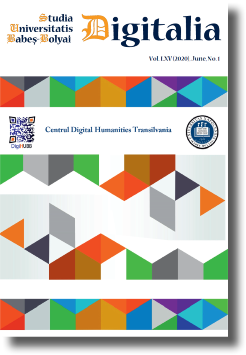Epigraphic Squeezes: Digitisation, Publication, and Enhancement
DOI:
https://doi.org/10.24193/subbdigitalia.2020.1.01Keywords:
Greek epigraphy, squeezes, database architectureAbstract
Epigraphic squeezes are a key tool for research and teaching. They also have historical and documentary value. They are reliable copies of inscribed text and become the only evidence that remains if inscriptions are lost or destroyed. This paper describes the Venice Squeeze Project for the preservation and enhancement of epigraphic squeezes in the Department of Humanities at Ca’ Foscari University of Venice. For the initial phase of the project, the Ca’ Foscari University collection of epigraphic squeezes was published in the digital ektypotheke E-stampages. The current phase involves developing a web application to digitise epigraphic squeezes according to the metadata architecture of E-stampages. The first part of this paper describes the background of the Venice Squeeze Project and methodological issues, which fostered the partnership with E-stampages. The second part describes the relational database that was set up to digitise the Ca’ Foscari collection. The third part introduces the project initiatives to promote a network of Italian institutions interested in digitizing their collections of epigraphic squeezes.
References
Antonetti, Claudia, Michèle Brunet, and Eloisa Paganoni. “Collezioni di calchi epigrafici: una nuova risorsa digitale”. Axon, vol. 3, no. 2, 2019, pp. 41–66, https://edizionicafoscari.unive.it/media/pdf/article/axon/2019/2/art-10.14277-Axon-2532-6848-2019-02-004.pdf
Antonetti, Claudia, Stefania De Vido. “Digital Epigraphy at the Greek Epigraphic Lab-oratory, Ca’ Foscari University of Venice”. Historika, vol. 7, pp. 491-502, https://www.ojs.unito.it/index.php/historika/article/view/2608/2442
Bevilacqua, Gabriella. “Da Federico Halbherr a Luigi Moretti, il percorso dell’epigrafia attraverso i calchi epigrafici della Facoltà di Lettere e Filosofia” dell’Università di Roma ‘La Sapienza’”. Mediterraneo Antico, vol. 16, 2013, pp. 563–582.
Bozia, Eleni, Angelos Barmpoutis, and Robert S. Wagman. “Open-Access Epigraphy. Electronic Dissemination of 3D-digitized Archaeological Material”. Information Technologies for Epigraphy and Cultural Heritage. Proceedings of the First EAGLE International Conference, edited by Silvia Orlandi, Raffaella Santucci, Vittore Casarosa, Pietro Maria Liuzzo, Roma: Sapienza Editrice, 2014, pp. 421–435, https://www.eagle-network.eu/wp-content/uploads/2015/01/Paris-Conference-Proceedings.pdf
Levivier, Adeline, Elina Leblanc, and Michèle Brunet. “E-STAMPAGES: archivage et publication en ligne d’une ectypothèque d’inscriptions grecques”. Les nouvelles de l’archéologie, vol. 145, 2016, pp. 24–27, https://journals.openedition.org/nda/3801
McLean, Bradley H. An Introduction to Greek Epigraphy of the Hellenistic and Roman Periods from Alexander the Great down to the Reign of Constantine (323 B.C.-A.D. 337). Ann Arbor: The University of Michigan Press, 2002.
Paganoni, Eloisa, Stefania De Vido, and Claudia Antonetti. “Il Laboratorio di Epigrafia Greca dell’Università Ca’ Foscari. Una fucina didattica per l’epigrafia greca”. 8th Annual Conference AIUCD 2019. Udine, 23 – 25 January 2019. Teaching and Research in Digital Humanities' Era. Book of Abstracts. Udine, 2019, pp. 193–195, http://aiucd2019.uniud.it/book-of-abstracts.
Downloads
Published
How to Cite
Issue
Section
License
Copyright (c) 2020 Studia Universitatis Babeș-Bolyai Digitalia

This work is licensed under a Creative Commons Attribution-NonCommercial-NoDerivatives 4.0 International License.


